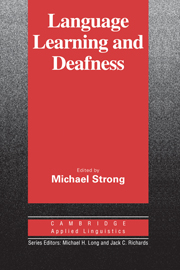Book contents
- Frontmatter
- Contents
- List of contributors
- Series editors' preface
- Preface
- SECTION I THEORETICAL ISSUES
- SECTION II RESEARCH REPORTS
- Chapter 6 An assessment of syntactic capabilities
- Chapter 7 Children's new sign creations
- Chapter 8 Linguistic and cultural role models for hearing-impaired children in elementary school programs
- Chapter 9 Acquiring linguistic and social identity: interactions of deaf children with a hearing teacher and a deaf adult
- Chapter 10 Development of vocal and signed communication in deaf and hearing twins of deaf parents
- Chapter 11 Questions and answers in the development of deaf children
- Index
Chapter 6 - An assessment of syntactic capabilities
Published online by Cambridge University Press: 05 October 2012
- Frontmatter
- Contents
- List of contributors
- Series editors' preface
- Preface
- SECTION I THEORETICAL ISSUES
- SECTION II RESEARCH REPORTS
- Chapter 6 An assessment of syntactic capabilities
- Chapter 7 Children's new sign creations
- Chapter 8 Linguistic and cultural role models for hearing-impaired children in elementary school programs
- Chapter 9 Acquiring linguistic and social identity: interactions of deaf children with a hearing teacher and a deaf adult
- Chapter 10 Development of vocal and signed communication in deaf and hearing twins of deaf parents
- Chapter 11 Questions and answers in the development of deaf children
- Index
Summary
Editor's introduction
In this chapter Berent discusses the performance of adult deaf learners of English on different syntactic structures using the interlanguage perspective that is currently in favor among second language acquisition researchers. With Chomsky's government-binding theory as a framework, Berent discovers a strong general preference for an explicit expression of the canonical NVN (SVO) word order of English finite clauses, which has also been reported in other studies. Possibly suffering from the limitations of a restricted working memory, deaf children, Berent suggests, are thus limited in their ability to extend core grammar to peripheral forms that are marked for various syntactic features. In the second part of the chapter, Berent reports on an attempt to teach certain syntactic structures to a group of students who had failed to show gains in English ability despite continued regular instruction. He found that the ceiling effect persisted among this group and suggests that the difference between deaf students that typically make slow gains and those that reach a ceiling may be related to the degree and nature of the processing limitations that they experience as a result of their hearing loss. The implications of this phenomenon for educators of the deaf are profound. It may be that the goal of teaching a nativelike fluency in English to deaf individuals is, with very few exceptions, an unrealistic one, and that research, as Berent implies, should focus on determining exactly which areas of English grammar are and are not amenable to deaf learners, a task that would certainly be anathema to most ESL teachers.
Information
- Type
- Chapter
- Information
- Language Learning and Deafness , pp. 133 - 161Publisher: Cambridge University PressPrint publication year: 1988
Accessibility standard: Unknown
Why this information is here
This section outlines the accessibility features of this content - including support for screen readers, full keyboard navigation and high-contrast display options. This may not be relevant for you.Accessibility Information
- 11
- Cited by
